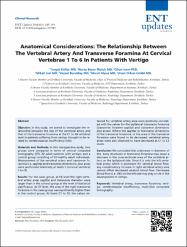| dc.contributor.author | Kültür, Turgut | |
| dc.contributor.author | Muluk, Nuray Bayar | |
| dc.contributor.author | Iyem, Cihan | |
| dc.contributor.author | Inal, Mikail | |
| dc.contributor.author | Burulday, Veysel | |
| dc.contributor.author | Alpua, Murat | |
| dc.contributor.author | Çelebi, Umut Orkun | |
| dc.date.accessioned | 2021-01-14T18:21:59Z | |
| dc.date.available | 2021-01-14T18:21:59Z | |
| dc.date.issued | 2018 | |
| dc.identifier.citation | Kültür T, Muluk N, Iyem C, Inal M, Burulday V, Alpua M, Çelebi U (2018). Anatomical Considerations: The Relationship Between The Vertebral Artery And Transverse Foramina At Cervical Vertebrae 1 To 6 In Patients With Vertigo. ENT Updates, 8(3), 185 - 194. | en_US |
| dc.identifier.issn | 2149-7109 | |
| dc.identifier.issn | 2149-6498 | |
| dc.identifier.uri | https://doi.org/10.32448/entupdates.507983 | |
| dc.identifier.uri | https://app.trdizin.gov.tr/makale/TXpnM056azFOUT09 | |
| dc.identifier.uri | https://hdl.handle.net/20.500.12587/13965 | |
| dc.description.abstract | Objective: In this study, we aimed to investigate the relationship between the size of the vertebral artery and that of the transverse foramina at the C1 to C6 vertebral level in patients suffering from vertigo thought to be related to vertebrobasilar insufficiency (VBI). Materials and Methods: In this retrospective study, two groups were compared in terms of cervical computed tomography (CT): 22 adult patients with vertigo; and a control group consisting of 23 healthy adult indivıduals. Measurement of the vertebral artery and transverse foramina (i.e. sagittal and transverse dimensions, plus area) were performed bilaterally at levels C (cervical vertebra) 1 to C6. Results: For the cases group, at C6 level the right vertebral artery area, sagittal and transverse diameter were larger than in the control group at the level of statistical significance. At C1 level, the area of the right transverse foramina in the cases group was significantly higher than in the control group. At levels C1 to C5, the values obtained for vertebral artery area were positively correlated with the values for the ipsilateral transverse foramina (transverse foramen sagittal and transverse dimensions plus areas). Where the sagittal or transverse dimensions of the transverse foramina, or the area of the transverse foramina were found to be decreased, vertebral artery areas were also observed to have decreased at C1 to C5 levels. Conclusion: We concluded that a decrease in diameter of the bony structures or transverse foramina may cause a decrease in the cross-sectional area of the vertebral artery on the ipsilateral side. Since it is only the left vertebral artery which is dominant for cerebral blood flow, any compensatory increase in right vertebral artery area cannot offset decreased cerebral blood flow. Decreased blood flow (i.e. VBI) on the left side may play a role in the development of vertigo. | en_US |
| dc.language.iso | eng | en_US |
| dc.relation.isversionof | 10.32448/entupdates.507983 | en_US |
| dc.rights | info:eu-repo/semantics/openAccess | en_US |
| dc.title | Anatomical Considerations: The Relationship Between The Vertebral Artery And Transverse Foramina At Cervical Vertebrae 1 To 6 In Patients With Vertigo | en_US |
| dc.type | article | en_US |
| dc.identifier.volume | 8 | en_US |
| dc.identifier.issue | 3 | en_US |
| dc.identifier.startpage | 185 | en_US |
| dc.identifier.endpage | 194 | en_US |
| dc.relation.journal | ENT Updates | en_US |
| dc.relation.publicationcategory | Makale - Ulusal Hakemli Dergi - Kurum Öğretim Elemanı | en_US |
















